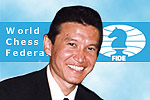| A.1 |
Rating |
|
It is advisable to check all ratings supplied by players. If no
reliable rating is known for a player the arbiters should make an estimation of
it as accurately as possible before the start of the tournament.
(to convert
German Ingo or British BCF use rating = 2840 - 8 x INGO = 600 + 8 x BCF)
|
| A.2 |
Order |
|
For pairing purposes only, the players are ranked in order of,
respectively
- score
- rating
- FIDE-title (IGM-WGM-IM-WIM-FM-WFM-no title)
- alphabetically (unless it has been previously stated that this criterion has
been replaced by another one)
The order made before the first round (when all scores are
obviously zero) is used to determine the pairing numbers: the highest one gets
#1 etc. |
| A.3 |
Score brackets |
|
Players with equal scores constitute a homogeneous score
bracket. Players who remain unpaired after the pairing of a score bracket will
be moved down to the next score bracket, which will therefore be heterogeneous.
When pairing a heterogeneous score bracket these players moved down are always
paired first whenever possible, giving rise to a remainder score bracket which
is always treated as a homogeneous one.
A heterogeneous score bracket of
which at least half of the players have come from a higher score bracket is also
treated as though it was homogeneous. |
| A.4 |
Floats |
|
By pairing a heterogeneous score bracket, players with unequal
scores will be paired. To ensure that this will not happen to the same players
again in the next round this is written down on the pairing card. The higher
ranked player receives a downfloat ( ), the lower one an upfloat ( ).
|
| A.5 |
Byes |
|
Should the total number of players be (or become) odd, one
player ends up unpaired. This player receives a bye: no opponent, no colour, 1
point. A bye is considered to be a downfloat. |
| A.6 |
Subgroups |
|
To make the pairing, each score bracket will be divided into
two subgroups, to be called S1 and S2.
In a heterogeneous score bracket S1
contains all players moved down from a higher score bracket.
In a homogeneous
score bracket S1 contains the higher half (rounding downwards) of the number of
players in the score bracket.
The number of players in S1 will be indicated
by "p", indicating the number of pairings to be made.
In both cases S2
contains all other players of the score bracket.
In both S1 and S2 players
are ordered according to A2. |
| A.7 |
Colour differences and colour preferences |
|
The colour difference of a player is the number of games played
with white minus the number of games played with black by this player.
After
a round the colour preference can be determined for every player.
- An absolute colour preference occurs when a player's colour difference is
greater that 1 or less than -1, or when a player played with the same colour in
the two latest rounds. The preference is white when the colour difference is
<< 0 or when the last two games were played with black, otherwise black.
In this case the (obligatory) colour is already written down on the score card.
(This rule is not in effect when pairing players with a score of over 50% in the
last round).
- A strong colour preference occurs when a player's colour difference is
unequal to zero. The preference is white when the colour difference is < 0,
black otherwise.
- A mild colour preference occurs when a player's colour difference is zero,
the preference being to alternate the colour with respect to the previous game.
In this case the colour difference is written down as +0 or -0 depending on the
colour of the previous game (white or black respectively).
Before the first
round the colour preference of one player (often the highest one) is determined
by lot. |
| A.8 |
Definition of "x" |
|
The number of pairings which can be made in a score bracket,
either homogeneous or heterogeneous, not fulfilling all colour preferences, is
represented by the symbol x.
x can be calculated as follows:
w = number of
players having a colour preference white.
b = number of players having a
colour preference black.
q = number of players in the score bracket divided
by 2, rounded upwards.
If b >> w then x = b-q, else x = w-q.
|
| A.8 |
Transpositions and exchanges |
- In order to make a sound pairing it is often necessary to change the order
in S2. The Rules to make such a change, called a transposition, are in D1.
- In a homogeneous score bracket it may be necessary to exchange players from
S1 and S2. rules for exchanges are found under D2. After each exchange both S1
and S2 are to be ordered according to A2.
|


